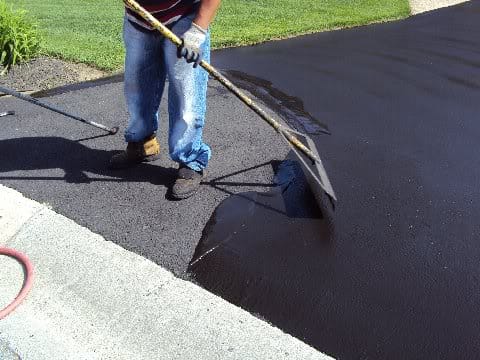Understanding Angled Parking: How Asphalt Sealing Boosts Industrial Lots
Understanding Angled Parking: How Asphalt Sealing Boosts Industrial Lots
Blog Article
Hot Mix Asphalt: A Lasting Solution for Sidewalk
Warm Mix Asphalt (HMA) has become a leading lasting choice for sidewalk services, using a myriad of ingenious technologies and ecological advantages. Its capacity to lower and recycle products power usage provides a compelling instance for its adoption in roadway building and construction projects. In addition, the lasting performance and resilience of HMA make it a favored option for framework development. As the need for green construction techniques expands, checking out the subtleties of HMA's sustainability can supply important insights into the future of sidewalk remedies.
Ecological Benefits of Hot Mix Asphalt

In Addition, Warm Mix Asphalt helps to alleviate metropolitan warm island effects. Its dark shade takes in sunlight, reducing the amount of warmth mirrored back into the ambience compared to lighter-colored pavements. This can reduce ambient temperature levels in urban areas, decreasing the demand for a/c and inevitably reducing power intake.
On top of that, Hot Mix Asphalt adds to boosted stormwater management. Its porous nature permits water to penetrate the sidewalk and recharge groundwater products, decreasing runoff and the danger of flooding. These environmental benefits make Warm Mix Asphalt a lasting option for leading freeways and roads.
Energy Efficiency in HMA Manufacturing
Is power effectiveness an important factor in the manufacturing of Hot Mix Asphalt (HMA)? Definitely. Energy plays a considerable function in the production of HMA, impacting both price and environmental sustainability. One vital element of power performance in HMA production is the usage of cozy mix asphalt (WMA) technologies (hot mix asphalt). WMA permits the blending and placement of asphalt at reduced temperatures contrasted to typical hot mix asphalt, resulting in lowered power intake throughout manufacturing. This procedure not only decreases gas usage yet likewise reduces greenhouse gas discharges, making it an extra eco-friendly choice.
Furthermore, advancements in plant technologies have actually led to more energy-efficient HMA production processes. By maximizing power usage in HMA manufacturing, the market can lower its carbon impact while maintaining top quality pavement materials.
Recyclability of Warm Mix Asphalt
The recyclability of Warm Mix Asphalt (HMA) is a critical element of its sustainability and long-lasting environmental impact. HMA is just one of the most recycled materials in the United States, with over 100 million heaps of reclaimed asphalt pavement (RAP) being recycled each year in brand-new sidewalk building and construction. Recycling HMA supplies several environmental benefits, such as minimizing the demand for virgin products, reducing energy consumption throughout production, and decreasing the amount of waste sent to landfills.
The procedure of reusing HMA involves milling the existing sidewalk, crushing it into smaller pieces, and blending it with new aggregate and asphalt binder to create a recycled mix. This recycled mix can frequently execute as well as and even better than standard HMA, while requiring less basic materials and generating reduced greenhouse gas exhausts. By integrating RAP into new pavement projects, road companies can conserve natural resources, decrease costs, and minimize the ecological impact of road building and maintenance tasks. Generally, the recyclability of HMA plays a significant duty in advertising lasting techniques within the pavement market.

Long-Term Performance of HMA
Asphalt sidewalks show resilience and resilience over a prolonged period, showing the long-lasting efficiency of Hot Mix Asphalt (HMA) Furthermore, innovations in HMA modern technology, such as the use of polymer-modified binders and cozy mix Web Site asphalt, have even more boosted the longevity and longevity of HMA sidewalks. By focusing on top quality building and construction and upkeep techniques, HMA continues to verify itself as a cost-effective and sustainable service for resilient sidewalk facilities.

HMA: Resilience and Sustainability
Showing both toughness and sustainability, Hot Mix Asphalt (HMA) has ended up being a cornerstone in the building and construction of long-lasting pavement infrastructures - regrading. HMA's sturdiness comes from its capacity to endure hefty tons, extreme weather, and high website traffic quantities, making it a reliable selection for streets, highways, and flight terminal runways. The composition of HMA, which generally consists of accumulations, binder, and filler, plays an essential role in improving its durability and resistance to damage
Moreover, HMA's sustainability exists in its recyclability and energy-efficient manufacturing procedure. The capacity to recycle reclaimed asphalt pavement (RAP) like it in brand-new HMA mixtures reduces the demand for virgin materials and minimizes the environmental impact of pavement construction and upkeep. In addition, the power performance of producing HMA exists in its reduced mixing temperatures compared to various other pavement materials, bring about reduced energy intake and greenhouse gas discharges.
Verdict
In final thought, hot mix asphalt (HMA) offers a sustainable option for pavement with its ecologically friendly features. HMA's recyclability, energy performance in production, and lasting toughness make it a green selection for road building and construction.
HMA is one of the most recycled materials in the United States, with over 100 million heaps of reclaimed asphalt pavement (RAP) being reused each year in brand-new pavement building.The process of recycling HMA entails grating the existing sidewalk, go to this web-site squashing it right into smaller pieces, and blending it with brand-new accumulation and asphalt binder to create a recycled mix.Asphalt sidewalks demonstrate toughness and durability over an extended period, reflecting the long-lasting efficiency of Hot Mix Asphalt (HMA) Furthermore, innovations in HMA modern technology, such as the usage of polymer-modified binders and cozy mix asphalt, have additionally enhanced the resilience and durability of HMA pavements. The capability to recycle redeemed asphalt sidewalk (RAP) in new HMA mixtures lowers the demand for virgin products and lessens the environmental influence of pavement construction and maintenance.
Report this page